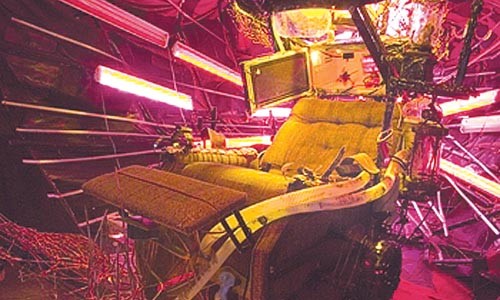
The Mattress Factory seeks to provide an environment for artists to create work they have always wanted to make, but couldn't. For the latest in the museum's Factory Installed series, five artists who each spent six weeks in residency took this mission to heart, creating ambitious works exploring the limits of physical space, personal experience or reality itself.
Each artist was assigned a gallery space. Taking stock of what he had -- light, a long room, a volume of air -- Washington, D.C.-based Dan Steinhilber responded to his space literally. Steinhilber's untitled, kinetic piece consists of a 30-by-50-foot tarp, industrial fans and other miscellany. The tarp, situated length-wise, is rigged to a garage-door opener that lifts and lowers it; simultaneously, the fans blow the tarp, producing a wave effect. Standing nearby, one feels as though about to be engulfed by a wave. Yet the fans' hum and the whining of the door-opener thwart any real associations with nature. It is as if the ebb and flow of water has been, ironically, transformed into a clattering, awkward machine, making the viewer feel somewhat uneasy.
"On Memory," a remarkable work by Deborah Aschheim, makes something tangible from the artist's ephemeral memories. Her installation exploring the limits of memory takes as its impetus her grandfather's struggle with Alzheimer's disease. During her residency, Los Angeles-based Aschheim decided to act as both a "research scientist" and her own "subject." Noting the involuntary way that memories appear, Aschheim observed her own thought process, then tried to map it.
On walls near the gallery's elevators, she placed bits of Mylar on which she had typed accounts of memories varying wildly in scope and chronology. Loosely connecting these scraps and interspersed nostalgic family photographs is a painted web of blue and purple lines. In addition, Aschheim crafted sculptures from vinyl tubing woven into intricate, nest-like webs -- "nerve-cell" sculptures that fill the large gallery. Lights within them suggest that memories are "lights turning on" in our brains. Inside each mass of tubing is a pod-like construction housing a small monitor playing home videos of Aschheim's family. It's as if we have walked into the mind of a stranger and been asked to sort through the data; one inevitably questions whether one's own memories alter our interpretations of hers.
Nick Cave's "A Quarter Til Ten" also deals with themes of memory and personal experience. This Chicago artist is best known for performances and wearable sculptures referencing issues of race and identity. Assigned the dark, somber space in the Mattress Factory basement, Cave turned it into something laboratory-like: an exploration of his experience as a black male. The space contains "specimens," collaged on the wall or arranged in grids on the floor. Rusty implements, an old chair, tools and bottles -- all reference time past. More pointedly, a black, 3-foot-high figurine wears a "headdress" made of clipper ships. Cave's strength lies in constructing thought-provoking juxtapositions of dissimilar objects.
Finally, Jesse Bercowetz and Matt Bua deal with the tenuous nature of reality itself. Their "Ships, Chips and the Stack of Documents" was inspired by an account of the "Philadelphia Experiment," in which a U.S. Navy ship was supposedly teleported from Philadelphia to Norfolk, Va., in 1943.
Standing outside the museum, looking up from the parking lot, one can see their sculpture of a battleship bursting from -- or crashing into -- a fourth-floor window. Inside the gallery, Bercowetz and Bua combined scrap wood, lights, televisions, conspiracy-themed video, fountains and miscellany to craft a dimly lit, psychologically discomforting space that might represent the interior of the ship. At the installation's center is an "electric-chair" crafted from a recliner and bent forks, and seemingly rigged to a microwave oven. At the other end of the gallery, a "life-size" alien sculpture keeps watch over a "reading room" containing conspiracy-related materials. The work combines a mad scientist's laboratory, a disaster site and a torture chamber, with an implicit nod to the sardonic and the humorous -- but is it really?
In this thought-provoking exhibition, all five artists ask us to re-evaluate both our experiences and our preconceptions.
Factory Installed continues through Jan. 28. The Mattress Factory, 500 Sampsonia Way, North Side. 412-231-3169 or www.mattress.org














